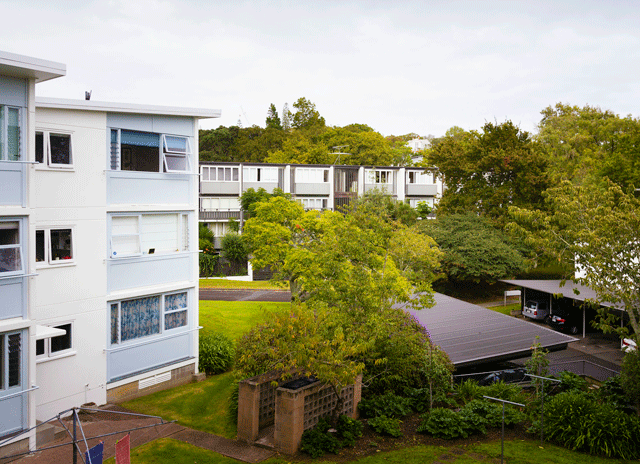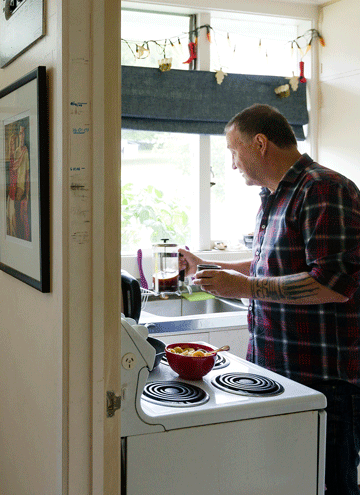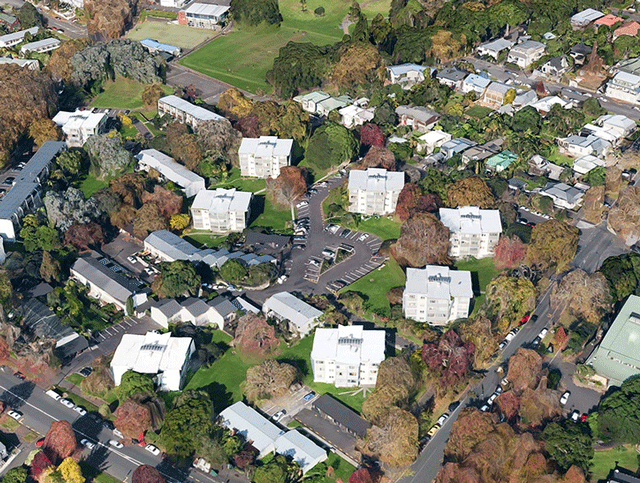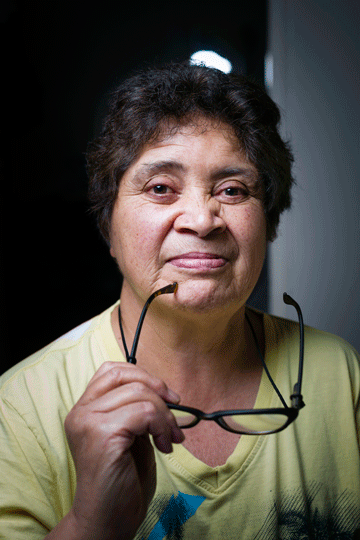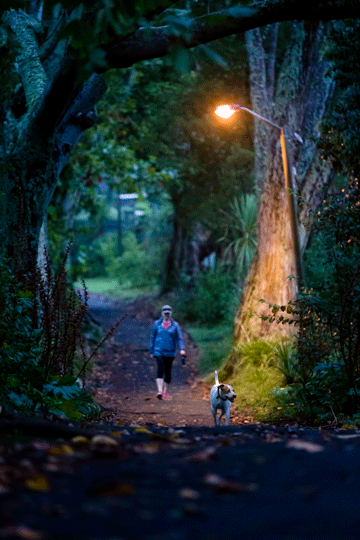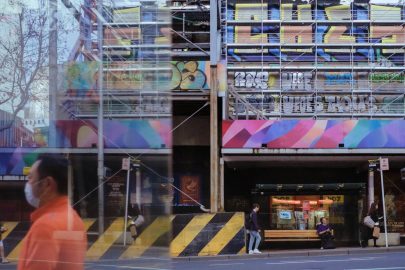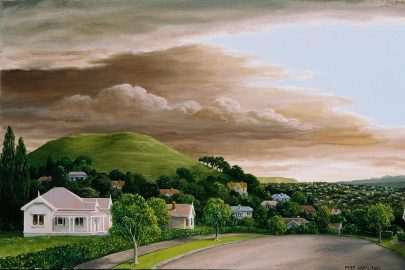Jul 19, 2015 Property
This story first appeared in the June 2015 issue of Metro. Photographs by Adrian Malloch.
Screaming child at my feet. Crying baby in my arms, leaden bags on my back. With a combination of dragging, wrestling and mock-abandonment (I walk off, my two-year-old eventually runs after me — not long ago I was aghast at mothers who did this), I’d made it the 50m or so from our car park, under the trees, and up the grassy bank to our low-rise apartment block.
I’d shouldered in through the back door, mum-handled us past the bikes and buggies into the main foyer. That was when Greer lay down and bawled. You see, she wanted to climb the trees. But six-month-old Francis was hungry. So was I. I stared at Greer coldly, hating this feeling of lost control, of parental incompetence, hating her for provoking it, hating myself for hating her… Then the door in front of us opened and Maggie popped her head out.
“Do you need a hand? I could take her up the stairs.”
“Oh, yes, actually, thanks, that would be great. Sorry about the noise…”
“Oh, don’t be silly. Greer, do you want a lift? Maggie give you a lift up the stairs?” Just quiet sobs now, as Greer looked up at Maggie, let her scoop her up. “You’re all right? You’re all right.”
And, just like that, I was all right, too.
Maggie had an English accent and longish blondish hair. I guessed she was in her 50s. She lived alone, with two adult kids in Auckland, one grandchild and another on the way. There was some weird feud going on between her and one set of neighbours; I didn’t really understand it but hoped it would blow over. Sometimes Maggie minded Greer to give me a break. Maggie wasn’t working because of health problems so she was there a lot: my downstairs rock. Other days, my stair-aid was seven-year-old Harry. He went to Freemans Bay School across the road and lived with his mum, a beauty therapist who always wore bright colours, and his sister — born days after Francis — one storey down from us. Harry’s mum is Rwandan and came here as a refugee.
We were living in what many New Zealanders would consider an untenable home for a family of four: a second-storey, two-bedroom, 71sqm rented apartment. When we arrived in mid-2011, it was just the two of us. The apartment was in Freemans Park, a complex of ex-council flats that now fetch up to $750,000. It had peeling, yellowed wallpaper; sludge-grey synthetic carpet flecked with neon pink and blue — think Penrose Industrial — a bathroom and laundry with no windows and worn vinyl. I loved it.
I loved that you could feel the intelligence and humanity of its design. The huge living room had an exterior wall entirely of glass and aluminium frame, with a ranch slider opening onto a false balcony and a view of trees, grass and the sloping footpath, giving an expansive sense of space and connection to the outside world. Also, the place, like many in the Park, was a sun-trap.
Freemans Park is a convivial scatter of neat, terraced “courtyard houses”, and three- or four-storey apartment blocks, set in pretty parkland, bordered by Hepburn St, Wellington St, Howe St and Beresford St West; while it qualifies as “medium density” (57 units per hectare), I never felt hedged in. At $360 rent a week, rising to $395, it was a bargain and we could walk, or bike, to most places we wanted to (10-20 minutes’ walk to Ponsonby Rd, Karangahape Rd, Victoria Park and Queen St).
We were even on-trend — the rising interest in “compact living”, with its hardcore “tiny house movement”, is a counterpoint to the bigger-is-better suburban McMansion model (now beyond the reach of the majority of Auckland’s would-be first-home buyers). Compact living near amenities is cheaper, simpler and sweeter; easier on the environment and on your sanity, converts rave. What you lose in household space you make up for in access to other kinds of spaces — social, recreational, retail.
Then I got pregnant, had a baby. We stayed on, made it work. It wasn’t always easy. But the last thing I wanted was to give up our CBD-fringe pad. I sensed the rupture between my pre-baby and post-baby life would be seismic enough without us physically transplanting. Sure, most nights I couldn’t get to any of those bars, restaurants, theatres, cinemas. At least I knew they were there, that city life in all its garish, exuberant, venal, transcendent glory was close by, within reach. And in stolen baby-free hours I could drop into a gallery or cafe to feel reconnected to my old life.
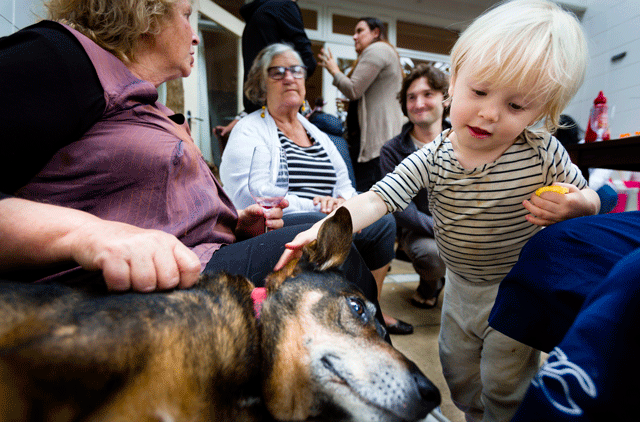
I was right. The next few years turned out to be a period of intense upheaval. I went from full-time, experienced magazine writer, sure of my daily life’s parameters and processes, earning the most I ever had; to mother-of-Greer, stunned mullet, a tender soup of emotions, hormones and bodily fluids (hers, mine); then mother-of-two — what was I thinking?
Greer arrived ravenous, mad and beautiful. Her birth was induced at 36.5 weeks because she’d stopped putting on weight and I had suspected pre-eclampsia. She was tiny: 1.89kg (4lb 3oz), and she stayed in hospital for a week until she could breastfeed. I’d walk to the hospital to feed her during the day, initially through a nasal tube, and wander home at night — down K’ Rd, on to Ponsonby, bursting to tell everyone, I JUST HAD A BABY, wondering how they could all just go on with their shopping and drinking and eating when something so immense had just happened: another human being, born! Out of me!
On the scale of births, it wasn’t especially traumatic. But I think it tipped what was always going to be a heightened experience, given my Tori Amos tendencies, into a swooning, plunging mindfuck. At six months, I wrote this to her: “First, I respected you, in your self-contained autonomy and agency — your person-ness. However much you depended on me, you were and are your own little being. Then I fell in love — baboom, baboom heart-thudding-in-chest. Now I’m delighted by and with you. The delight plays out over top of the love and respect, light dancing on the floor in the late afternoon, pinging off your mobile suspended over the change table and draped over the lampshade.”
See what I mean?
Things become so interior when you have your first baby. Physically and psychically: you become intimate with your domestic setting and, uncomfortably, your private tyrannies. Also with your capacity for loving and for silly joy (we actually applauded the first time baby Greer, lying on the ground, pushed a folded-up bib off her face). There were hours on our rose-gold couch feeding Greer in the rose-gold light of suspended-time evenings; watching out of that huge lounge window-wall as the leaves blazed, withered and fell; padding between bedroom, bathroom and lounge on that forgiving carpet; gingerly bathing her in that cruddy but clean bathroom. When she was seven months old, our shared office became her bedroom. We moved our desks into the lounge, which became five rooms in one: playroom, lounge, dining room, and two offices. Headphones came into their own.
Chronic sleep deprivation made things even more… intense. I couldn’t bring myself to let her cry to sleep — one of my tyrannies was the immense pressure I put on myself to ensure Greer didn’t have one millisecond of discomfort or distress (which I now realise was utterly implausible, the internalised masochistic mamma-meme of the Perfectly Naturally Intuitively All-knowing Mother, but that’s another story). So, by eight months, I was periodically in tears for how tired I was. And oh, the rage I flung at my partner, for having more sleep, more of a social life, than I did. If I couldn’t sleep, I knew I needed adult company to maintain any sort of equilibrium. So I stopped a woman pushing a pram through the complex’s central car park one day and asked if she lived here (she did, we had play dates). I chatted up other new parents at the local playground in Western Park, where I swear I spent a full month of my life pushing a swing. I set up a coffee group for Freemans Park mums (it was short-lived due to fickle nap times and other commitments, but at least we knew we were all a text and a moment’s walk away). I joined the local Playcentre, introduced by another Freemans Park mum.
I know I’d have sought out that kind of community if I’d been living in a detached suburban house. But there’s something about having your own fenced-in property that makes you feel that you are, and should be, self-contained — practically, emotionally. And something about the common grounds — all those lawns you never have to mow! — and absence of fences at Freemans Park that softens boundaries between people. The larger pool of close neighbours, and higher frequency of passing exchanges, gave me a higher chance of meeting like-minded or like-situated people. Being central, I was also easier to visit for both central and far-flung friends. I’m so glad I lived in Freemans Park for this period — isolation (real or imagined) may well have tipped me into postnatal depression.
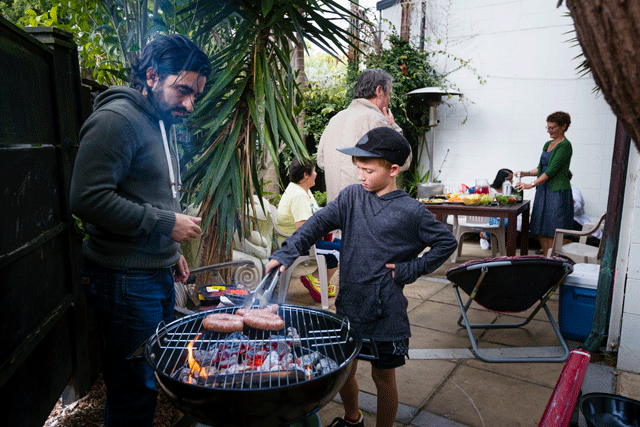
The Ghetto. The Commune for Capitalists. It feels like anyone who’s ever lived or worked centrally in Auckland knows someone who’s lived here, in one of these 201 flats on the steep green flanks of Freemans Bay. This place attracts creative types: architects, designers, artists, media and hospo folk. All sorts live here, though. In our block lived a beautician, TV cameraman, schoolteacher, carpenter, office worker, architects, stay-at-home mums, church minister/artist, graphic designer, urban designer, IT guy, pub singer, chef, art tutor, university students, kids and babies.
When we brought Greer home from the hospital, Gloria Tukaki, who lived on the ground floor of a “star block” across from us, came over and showed us how to hold Greer up to the four winds as a welcoming and safety gesture. Tukaki, 58, has lived in her one-bedroom flat for 10 years. She knows most people in the Park, by first name at least. Of Ngai Te Rangi descent, her family live on Matakana Island, off Tauranga. Some people call her the resident kuia. I asked if she saw herself like this. “Ooh, that’s a very dutiful word. I’d rather be called an aunty. To the kiddies, anyway. I’m such a nosy parker — put that down, yeah. And I start being nosy just by saying hello.”
Living here has been transformative for her, she told me. “For a person who was born with a physical disability — left-sided hemiplegia, and since I had a stroke a few years ago, I have no use of my left arm — being here, around these people, has made me feel so independent, because they’re there and yet they’re not there; they come when they need to. I can yell out to any one of them. And it’s the same for them, too.”
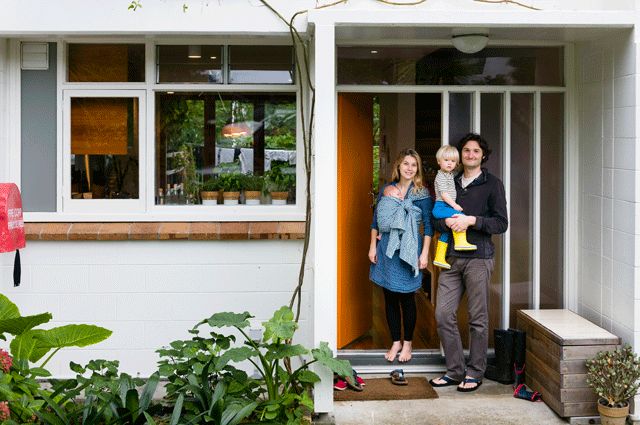
Tukaki rents from Housing New Zealand. (Many HNZ tenants in the Park are terrified their homes will be sold.) Apart from the park setting, this is what makes Freemans Park so unusual: more than a quarter of the flats are social housing. HNZ owns the majority; a community housing organisation for people with mental health and addiction issues owns 10. The other three-quarters are private rentals (like ours) or owner-occupied. People in six-figure households live right by people on benefits or earning minimum wage. Some of the owner-occupiers and private tenants are funny about the social housing tenants’ presence — look down on them, resent their cheap rents or their feared dampening effect on property values — but plenty aren’t.
“You know people as people here. Whether they rent or own or rent off Housing New Zealand, it doesn’t matter,” Annette Jones told me. Jones bought her two-bedroom courtyard house from the council for $238,000 in 1998. She’s bringing up her three boys — the eldest is 12, the twins are 10 — without a partner, while working as an urban designer with engineering consultancy Beca. She has a direct, no-bullshit style and exudes capability.
I also liked how Richard Archbold put it. He and his partner, Ana, own and live in a three-bedroom courtyard house (there are only eight three-bedroom units in the Park; 148 two-bedrooms and 45 one-bedrooms). They bought in 2011. He works for Warren and Mahoney Architects, she’s a lawyer. He grew up on a sheep farm at Cheviot, North Canterbury, a world away. A cheerful, contemplative fellow, he jokes about being the only architect in town who can shear sheep.
“In Auckland,” he said, “you see diversity in the numbers but not reflected in the inner city: that is a loss. You don’t build a city by creating spaces that are exclusively about commerce, where you can enjoy them only if you can afford $14 for a glass of pinot gris. The group of people who live here are a community, and this community is stronger with diversity. And if those Housing New Zealand places went, we’d lose something significant.
“Ghettos are not about income level, they’re about homogeneity: if everyone’s rich it’s still a ghetto, just a ghetto of rich people, which is worse!” He laughed. “This development is a last vestige of a modernist utopian view, which is not just about parklands and space but having social diversity.”
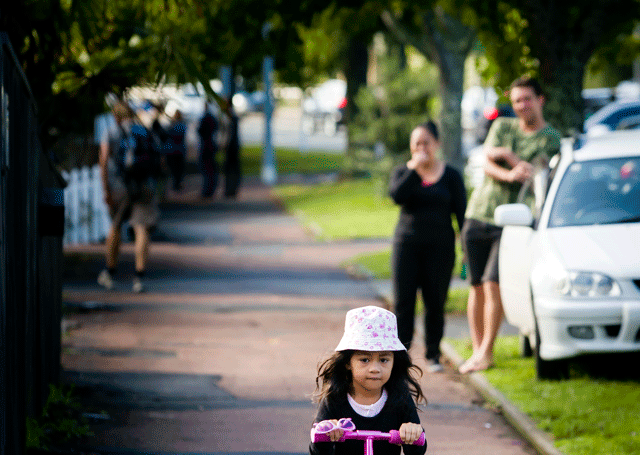
The history of Freemans Bay is one of waves of settlement and displacement driven by competing ideas of “improvement”. The history of Freemans Park is the history of one of those ideas working for a group of people, then for another, with ongoing settlement and displacements.
Modernism made its mark on Freemans Bay in the context of slum clearance. A rejection of tradition, old certainties and structures, modernism was a reaction to the upheavals of industrialisation and the mass destruction of WWI. It shook up the humanities and arts through the 20th century. Straight after WWI, Europe and Britain faced a massive housing crisis: millions of displaced citizens needed new housing, as did denizens of its urban slums. Architects conceived of a new model of urban renewal: the apartment tower in the park (high-density, humanising natural setting). It caught on, leading to the razing of entire districts of historic buildings and the construction of high-rise apartments in communal gardens.
For the first half of the 20th century, Freemans Bay, this leafiest of suburbs, was a working-class slum fringed by belching factories. A 1946 article in the Auckland Star said: “Aucklanders young and old are living in filthy, unsanitary surroundings in the heart of the city. In disused shops, ramshackle apartment houses and small slummy dwellings, people are carrying on.”
“Affluent parents would take their children on Sunday drives to the bay for a cautionary look at the slums,” wrote Jenny Carlyon and Diana Morrow in their 2008 history Urban Village.
A former resident who emailed those authors, though, remembers “an amazing camaraderie… Even though our rented house in Wellington St could have done with a few repairs… to me it was a safe haven of sunshine pouring in through the big sash windows.”
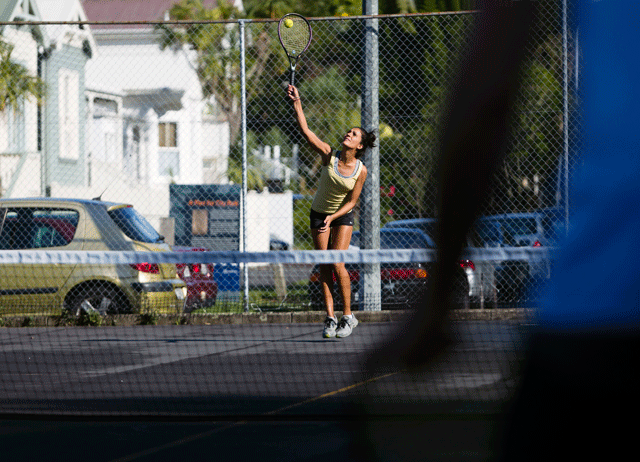
In 1951, 338 acres (137 ha) of Freemans Bay was earmarked for slum clearance: an area bounded by College Hill, Ponsonby Rd, Hopetoun St, Nelson St, Fanshawe St, Halsey St and Victoria St. After a burst of demolition came almost two decades of inaction: by 1968, only nine hectares had been bulldozed and redeveloped. Thousands moved out to escape the limbo and deteriorating conditions. The old slum’s stable, close working-class community gone, Freemans Bay became dominated by highly mobile tenants, many newly arrived from the Pacific. With pressure from residents, in 1973 the council finally redesignated the remaining area for rehabilitation and renovation. Hello villa do-ups. House values climbed, rents rose, and gentrification drove up in her Audi. Another wave of displacement followed, this time due to market forces. Pakeha middle-class people moved in; Maori, Pacific Islanders and the working-class moved out.
People suffered from the ineptitude and tyranny of council slum clearance. However, there was intelligence and humanitarianism in the visions council planners and architects had for Freemans Bay’s redevelopment: that “modernist utopian view” epitomised by Freemans Park. Here’s its rationale, as described in a 1949 Auckland Star article: “…blocks of flats of reasonable height can provide close-in living in park-like surroundings for families without small children, young couples in which both members may be working, or their in-laws. Only by this means can suburban tracts be saved for families who need more space without adding to an already tough transport schedule.”
Freemans Park is hailed in design circles as a breakthrough: a modernist urban housing scheme that works. The now-prized star block (named for its star-like arrangement of flats) was a standard social housing block developed by government department architects (Neville Burren, working under Fred Newman and F Gordon Wilson). The Park’s nine star blocks were built from 1960 to 1967, followed by the maisonettes (blocks of two-storey flats stacked two or three high) and terraced courtyard houses, which were purpose-designed by Auckland City architects.
In the late 1960s, the council brought in respected landscape architect Harry Turbott to design the park in which the buildings sit.
Council tenants moved in and established another strong community, until the Les Mills-led council began selling off flats in 1997, contending that housing was non-core council business.
Kimberly Smith spits on this. She’d lived in Freemans Park with her six-year-old son for eight months when she got wind, in 1995, of the council’s plans to sell all the flats and other nearby council housing. She was doing a degree in psychotherapy. As she recalls it, that modernist utopia was a reality before the sell-off.
“Kids skateboarding, trampoline, swings; tenting overnight. Topless sunbathing all over the show. Men working on cars in the car park. Picnics. It was an extraordinary community. A lot of people who had mental health issues but managed in supported housing, and a community that was really tolerant. A lot of solo mums, elderly people, and lots and lots of kids. The Maori immersion unit was set up at Freemans Bay School to service the kids, and it struggled when they left.”
Graeme and Joan MacRae moved in as council tenants around the time Smith did. A gentle, bookish, sandals-and-scarves couple who speak in tandem, they told me a woman called Ruby had a huge veggie garden behind our star block, where now there’s only grass and garden borders. Graeme, who’s now a senior lecturer in anthropology at Massey University, bears a wry appreciation of the absurd. He sent me a chapter about Freemans Bay he wrote for the book 11 Views of Auckland. It recalls mid-1990s Freemans Park: “Not many people had cars and there were plenty of empty spaces in the car park for dead vehicles and renovation projects. There was a caretaker, an Englishman who spent much of his day reading the newspaper and surveying his empire from a chair in the sun outside his little office under one of the three-storey ‘star blocks’. He did, however, happily change fuses and light bulbs for the little old ladies and help people who locked themselves out of their flats.”
Smith became a driving figure in three years of tenant action against the sales. Opponents marched, gathered 5501 signatures on petitions, made submissions, but to no avail. Residents were offered first refusal and a 7.5 per cent discount, but many still couldn’t afford to buy their homes. Meanwhile, the council raised rents, forcing lower-earning tenants out.
“It was a very cruel process. There were three suicides… What happened most of all was the removal trucks arrived and a lot of people just ghosted away of an evening,” recalled Smith.
Out of the tenants’ action group evolved Auckland Housing Association (AHA), which eventually bought 20 flats and helped tenants into mortgages.
“That meant that 16 individuals and families, all people who never imagined they’d ever own their own home, went into a collective purchasing deal with the AHA,” explained Smith.
Among them were the MacRaes. Smith was set to purchase her flat when she inherited her brother’s kids in tragic circumstances, which made her ineligible for a mortgage. She moved across the road from the Park, where she lives today. AHA still rents out four flats at 75 per cent of the market rate, with tenants chosen according to income and need.
In August 1998, the New Zealand Herald ran a story about the Park headlined “Private Enterprise”. Chair of a newly established owners committee, John Balasoglou, was quoted talking about what could be done with all the green spaces. “Perhaps we could put in tennis courts, swimming pools or even a citrus grove,” he said. The communal laundries in some of the buildings could be converted to meeting rooms or gyms. “It’s going to take time. We’re gradually moving from a council-run area to a privately run one. We’re trying to make it a nicer place in which to live.”
Two months later, a new, more liberal council elected under Christine Fletcher halted the sales. New owners felt gypped, worried that remaining council flats would hurt resale values. Council tenants felt at sea. Already, the Park was markedly whiter and wealthier. Then John Banks became mayor in 2001, and his council resumed the sales process. Housing New Zealand intervened and bought the remaining flats.
Smith remembers a culture clash between the new owners and social housing tenants over these years. “Most of the people who bought were single, childless, desperate to be on the property ladder and make capital gains. All the flower gardens got ripped out because there was this thing about wanting to create a woodland and roses weren’t appropriate. People’s vegetable gardens were ripped up. The swings and trampoline went. Sunbathing was frowned upon. Then those people began to have babies and things softened.”
In his chapter, Graeme MacRae gently parodies the grand designs and petty politics of the various body corporate committees who have tried to improve the Park since 1997.
“The Park became the vehicle for all sorts of people’s fantasies,” he told me. “They created trouble but none of them really succeeded; they’ve been the ones who were driven out.”
“The place had a strength of its own,” said Joan.
“Yes: it broke those people,” said Graeme.
I said I’d been reflecting on how Aucklanders need to get their heads around body corporates as more of us will have to live within them. We swap arcane mortgage tips at barbecues, but glaze over at committee politics. Graeme agreed: “Body-corporate culture is very different from suburban homeownership culture which is really a scaled-down version of rural culture — which is ‘really good fences make good neighbours’. I remember in the early years the problem with a lot of people buying here was they thought they were buying a freehold property with a fence around it where they could do what they liked, and they had no sense at all that what they were buying was a share in a collective space; I think a lot of people still don’t really understand that.”
Chris McBride, who lives two along from the MacRaes, raised the idea of body corporates maintaining more than the material place. I’d always known McBride as owner-of-Butter, the endlessly tolerant tortoiseshell who provided my kids’ — and many other kids’ — first feline encounters. An artist, McBride applied for a Housing New Zealand flat here 14 years ago because he wanted his daughter to go to the Maori immersion unit at Freemans Bay School. He got it, and she grew up in the Park.
“There’s no mandate for the body corporate to be involved in the social life of the community,” he observed. “The body corporate is about building an asset and keeping that right. I think building a community and keeping that right is part of building an asset.”
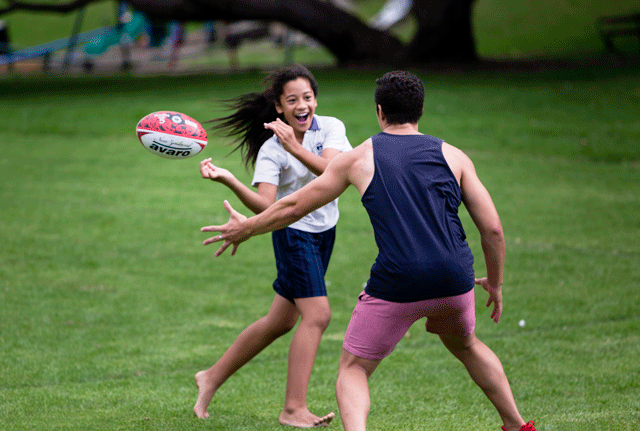
Community. Before I had kids, I knew you were meant to value your local community, but it just didn’t have anything to do with my life. I had flatmates, friends, work colleagues, familiar faces at the gym. They were my Auckland community; I didn’t even know my neighbours. Community: such a dreary, worthy word. Poor people, lonely people, sick people, people with messy, noisy, spilling-over lives; people who yell at their kids and each other in public. People with bad skin, bad hair, bad clothes. Right-on lefties earnestly tending community gardens, trying to bury their resentment at lazy neighbours who plunder the produce (generosity makes you a better person). Hard-faced rule-sticklers objecting to DIY-obsessed neighbours’ deck extensions, zealously monitoring on-street parking. Community: isn’t living with family an imposition enough?
Except, of course, now I get it. Annette Jones gets it, too. She grew up in Howick when it was rural fringe; now she’s almost evangelical about Freemans Park’s compact-but-spacious central living and the community it fosters. “This place I liken to a formalised campground. Kids play and everyone keeps an eye on them. People comment to me because I have three kids in one bedroom, but I say they have three hectares. I go around and say to them, this is where you can play, this is the perimeter, and it gets bigger as they get older. There’s nothing these kids are missing out on, except for their own bedroom. It’s not for everybody, but you make the best of it; this is what I can afford.”
She agrees the lack of fences makes it harder with preschoolers. “When I first arrived there were lots of kids, then there was a period where there were no kids and I moved out because it wasn’t the right place for my kids. And then everybody had kids and I moved back. None of those people who had kids have moved out; some have moved from two-bedroom to three-bedroom, but they’re growing their families here.”
Naturally, Gloria Tukaki kept an eye on it all. “Police coming in and out, people roaming around, young people who think they can take the grog, and who are stumbling around here — those are the best ones to watch, but those years are gone, they’ve all grown up and become adults themselves. I’ve seen people bring their babies home and I still see them around — I see them walk, run around, just like your two.”
Jones organised for her friend, architect and fellow owner-occupier Christina van Bohemen, and her newish neighbour, Emilio Garcia, who lectures in sustainable architecture at the University of Auckland, to meet me at her place one night.
I asked about the Special Housing Areas created to provide badly needed affordable housing in the city: any lessons from Freemans Park?
“It’s hard to recreate this: a development with some social housing,” said van Bohemen.
Jones added: “It’s an anomaly — they wouldn’t create something with so much green space and landscaping… this was a top-down solution, and I don’t think developers would have been able to afford to do this unless the buildings were taller.”
Later, the idea of a “compact city” came up. This urban design model, favoured by Auckland Council, generally involves raising population density and limiting sprawl: growing up rather than out, living closer together, with better public transport (Auckland’s Unitary Plan diverges from compact-city orthodoxy in several ways, most obviously in pushing out Auckland’s boundaries to allow for up to 90,000 new homes to be built by 2041 on what’s now rural land).
Garcia, who comes from Argentina and lived in Mexico before immigrating here, warns against Auckland uncritically adopting models that worked overseas but may not work here. He mentions research that suggests compact cities, such as Vancouver, are expensive due to high demand and infrastructure costs, and can exacerbate inequality by driving poorer people out to the sprawling edges. Nor are they necessarily more environmentally sustainable: people who use the train to get to work all week still take weekend getaways by road or air. Sustainability is as much about changing behaviour as changing design, he said.
Jones observed Auckland will have to find a suitable solution for each community. “The biggest thing about Auckland is it’s a series of villages with main streets, that’s what people defend. So how do you develop behind the main street? What’s been interesting is in the last 10 years the supermarket in Howick that never did very well has been converted into apartments — the first of many in a walkable ring. That’s a New Zealand approach.”
“Heresy for an architect to say it,” said van Bohemen, “but I’m less concerned about the design of our buildings. It’s the design of our public spaces that’s a bigger priority. Yes, of course we need interesting and innovative architecture to inspire us and create different experiences, but we need great streets that people want to be in.”
Most of the time, I want to be in the street we live on now. Last year, we could finally afford to buy a house (with family help and a Kiwisaver deposit subsidy), and we moved out west. Our new home, a dinky 1940s cottage in Glen Eden, has three bedrooms, though it’s still small by modern standards: 135sqm, compared with an average new build in Auckland of 203sqm in 2013 (76sqm in the UK and 109sqm in Germany). Still, it’s a detached house — yards back and front, deck, garden. My partner’s CBD work commute went from a 10-minute walk to a 40-minute train-and-walk.
Why did we move if it was so peachy at Freemans Park? We wanted the security of owning (I kept bracing myself for a letter saying we had x weeks to move out because the landlord was selling. This happened to me three times during the 2000s property boom). And, yes, we wanted a fenced back yard for the kids. And a chance at capital gain. We looked into Hobsonville Point, a public-private housing development which, with its inclusion of compact affordable housing, is possibly the nearest present-day Auckland equivalent to Freemans Park. But those “affordable” three-bedrooms were $80,000 out of our reach. So, we looked for somewhere on the train line, somewhere we could imagine feeling at home.
The vibe in Glen Eden is proud, resourceful, staunch, generous, with a good shot of pugnacity. My favourite float from the deep-bogan Glen Eden Christmas Parade: “Westie Working Wenches” — women in purple corseted dresses and red headdresses waving and bantering with onlookers. As people keep saying, it’s a good community; we’re finding it easy to make new friends (it also helps that my mothering-intensity has eased: I’m sleeping better, working more, getting out more). It’s so much poorer out here: the Sallies’ Family Store is a hub; Glen Mall is chocka with two-dollar shops and bakeries selling white filled rolls and cream buns.
Whenever I return to Freemans Park, I feel a pang of loss for the soothing green setting, proximity to town, the good people living there. But as a tenant, I’d never made an emotional commitment to the place; I knew we’d eventually leave, and that we couldn’t afford to buy anywhere central.
I keep thinking of something that media agency owner Alistair Wilkinson, who used to own a flat in Freemans Park, said in a New Zealand Herald story. “It represents a particular time in our social history and a particular idea about what public housing should be — that everybody deserved to live close to the city yet be in park-like grounds.”
How outlandish, how indulgently fantastical that sounds today! The idea that a subsistence income (and whatever set of circumstances delivered this financial precariousness) shouldn’t bar you from living centrally — or, for that matter, in any suburb — would twist the mouth of many a mid-income first-home seeker forced to buy ever further away from their jobs and flatting stomping ground.
I don’t believe we “deserved” to be able to buy in Freemans Park, as much as I loved living there. I do believe we, and all private tenants, deserved the option of long-term tenure, and far higher minimum standards for rental properties, and far better enforcement of current standards. I also reckon people like Gloria Tukaki and Chris McBride deserve to stay in their homes, where their lives are anchored; and that so-called social (subsidised) housing belongs in all suburbs. Isn’t all housing, above all, “social”? Why shouldn’t this be reflected in rules for private rentals as well as in economic mechanisms, such as taxes, to privilege owner-occupiers over property investors?
Everyone deserves an Auckland with more smallish, reasonable-to-high- quality new homes that would meet a pressing and growing need for cheaper but liveable homes, and a growing appetite from downsizing boomers for high-end apartments and townhouses. A city of safe, beautiful, inviting communities designed sensitively around existing high streets and hubs with plentiful interconnections (roads, rail, bus lanes, cycleways…). A city built for all Aucklanders.
A modernist utopian fantasy?
The thing is, it’s not utopia. It’s been done already.

